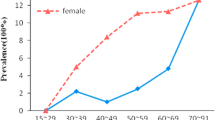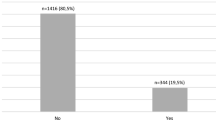Abstract
Background
Type 1 diabetes (T1DM) often coexists with other autoimmune diseases, most commonly with hypothyroidism. To date, the influence of coexisting autoimmune hypothyroidism (AHT) on the course of chronic neurovascular complications of autoimmune diabetes has not been established. The aim of the study was to assess the relationship between AHT and the occurrence of chronic T1DM complications.
Methods
The study group comprised 332 European Caucasian participants with T1DM [165 (49.7%) men]. AHT was recognized in subclinical and overt hypothyroidism and confirmed by the presence of anti-thyroid autoantibodies: anti-peroxidase (ATPO) and/or anti-thyroglobulin (ATg) and ultrasonography (hypoechogenicity, parenchymal heterogeneity, lymph nodes assessment).
Results
In the analyzed group, 48.5% of patients were diagnosed with at least one neurovascular complication. At the time of enrollment, 16.3% of participants were diagnosed with AHT. Patients with AHT, compared to those without AHT, were characterized by a higher prevalence of neurovascular complications (64.8 vs. 45.3%; P = 0.009) and retinopathy (55.6 vs. 38.9%; P = 0.02). There were significant differences between groups with and without neurovascular complications, with regard to classic risk factors for chronic diabetes complications: age, T1DM duration, SBP, DBP, HbA1c, TG, eGFR and hypertension prevalence. In the multivariate logistic regression analysis, AHT was an independent predictor of neurovascular complications after adjusting for age, DBP, HbA1c and TG (odds ratio, 2.40; 95% confidence interval, 1.17–4.92; P = 0.02).
Conclusions
AHT coexisting with T1DM was associated with a higher incidence of neurovascular complications.
Similar content being viewed by others
References
Chang CC, Huang CN, Chuang LM (1998) Autoantibodies to thyroid peroxidase in patients with type 1 diabetes in Taiwan. Eur J Endocrinol 139(1):44–48
Barker JM et al (2005) Autoantibody “subspecificity” in type 1 diabetes: risk for organ-specific autoimmunity clusters in distinct groups. Diabetes Care 28(4):850–855
Kordonouri O et al (2002) Thyroid autoimmunity in children and adolescents with type 1 diabetes: a multicenter survey. Diabetes Care 25(8):1346–1350
ADA (2018) 2. Classification and diagnosis of diabetes: standards of medical care in diabetes-2018. Diabetes Care 41(Suppl 1):s13–s27
Huang W et al (1996) Although DR3-DQB1*0201 may be associated with multiple component diseases of the autoimmune polyglandular syndromes, the human leukocyte antigen DR4-DQB1*0302 haplotype is implicated only in beta-cell autoimmunity. J Clin Endocrinol Metab 81(7):2559–2563
Mohn A et al (2002) The effect of subclinical hypothyroidism on metabolic control in children and adolescents with Type 1 diabetes mellitus. Diabet Med 19(1):70–73
Biondi B, Klein I (2004) Hypothyroidism as a risk factor for cardiovascular disease. Endocrine 24(1):1–13
Soedamah-Muthu SS et al (2004) Risk factors for coronary heart disease in type 1 diabetic patients in Europe: the EURODIAB Prospective Complications Study. Diabetes Care 27(2):530–537
Araszkiewicz A, Zozulinska-Ziolkiewicz D (2016) Retinal neurodegeneration in the course of diabetes-pathogenesis and clinical perspective. Curr Neuropharmacol 14(8):805–809
Fong DS et al (2004) Retinopathy in diabetes. Diabetes Care 27(Suppl 1):S84–S87
Matsushita K et al (2012) Comparison of risk prediction using the CKD-EPI equation and the MDRD Study equation for estimated glomerular filtration rate. JAMA 307(18):1941–1951
Sonne DP, Hemmingsen B (2017) Standards of medical care in diabetes-2017. Diabetes Care 40(Suppl. 1):S1–S135
National Kidney Foundation (2012) KDOQI clinical practice guideline for diabetes and CKD: 2012 update. Am J Kidney Dis 60(5):850–886
Tesfaye S et al (2010) Diabetic neuropathies: update on definitions, diagnostic criteria, estimation of severity, and treatments. Diabetes Care 33(10):2285–2293
Rogowicz-Frontczak A et al (2011) Carotid intima-media thickness and arterial stiffness in type 1 diabetic patients are dependent on age and mean blood pressure. Exp Clin Endocrinol Diabetes 119(5):281–285
Spallone V et al (2011) Cardiovascular autonomic neuropathy in diabetes: clinical impact, assessment, diagnosis, and management. Diabetes Metab Res Rev 27(7):639–653
Camm AJ et al (1996) Heart rate variability: standards of measurement, physiological interpretation and clinical use. Task Force of the European Society of Cardiology and the North American Society of Pacing and Electrophysiology. Circulation 93(5):1043–1065
Kitahara CM et al (2012) Body fatness and markers of thyroid function among U.S. men and women. PLoS One 7:e34979
Rogowicz-Frontczak A et al (2016) Patients with diabetes type 1 and thyroid autoimmunity have low prevalence of microangiopathic complications. Endocrine 51(1):185–188
Mancia G et al (2013) 2013 ESH/ESC guidelines for the management of arterial hypertension: the Task Force for the Management of Arterial Hypertension of the European Society of Hypertension (ESH) and of the European Society of Cardiology (ESC). Eur Heart J 34(28):2159–2219
Schalkwijk CG, Stehouwer CD (2005) Vascular complications in diabetes mellitus: the role of endothelial dysfunction. Clin Sci (Lond) 109(2):143–159
Cebeci E et al (2011) Evaluation of oxidative stress, the activities of paraoxonase and arylesterase in patients with subclinic hypothyroidism. Acta Biomed 82(3):214–222
Ates I et al (2015) The relationship between oxidative stress and autoimmunity in Hashimoto’s thyroiditis. Eur J Endocrinol 173(6):791–799
Yang JK et al (2010) An association between subclinical hypothyroidism and sight-threatening diabetic retinopathy in type 2 diabetic patients. Diabetes Care 33(5):1018–1020
Kim BY et al (2011) Association between subclinical hypothyroidism and severe diabetic retinopathy in Korean patients with type 2 diabetes. Endocr J 58(12):1065–1070
Qi Q et al (2017) Association of thyroid-stimulating hormone levels with microvascular complications in type 2 diabetes patients. Med Sci Monit 23:2715–2720
Yasuda T et al (2011) Subclinical hypothyroidism is independently associated with albuminuria in people with type 2 diabetes. Diabetes Res Clin Pract 94(3):e75–e77
Asvold BO, Bjoro T, Vatten LJ (2011) Association of thyroid function with estimated glomerular filtration rate in a population-based study: the HUNT study. Eur J Endocrinol 164(1):101–105
Rodacki M et al (2014) Should thyroid-stimulating hormone goals be reviewed in patients with type 1 diabetes mellitus? Results from the Brazilian Type 1 Diabetes Study Group. Diabet Med 31(12):1665–1672
Acknowledgements
We thank Malgorzta Grzelka and Jaroslaw Opiela for language revision of this article.
Funding
This research did not receive any specific grant from any funding agency in the public, commercial, or not-for-profit sector.
Author information
Authors and Affiliations
Contributions
ARF and BF planned and designed the study. AGW, AU, AA conducted data acquisition. BF performed the statistical analysis. ARF and BF wrote the manuscript. AGW, AU, AA, DZZ revised the manuscript. All authors approved the submitted version.
Corresponding author
Ethics declarations
Conflict of interest
The authors declare that they have no conflict of interest.
Ethical approval
All procedures performed in the studies involving human participants were in accordance to the ethical standards of the institutional and/or national research committee (The Bioethical Committee of Poznan University of Medical Sciences; reference numbers: 539/12 and 465/15) and with the 1964 Helsinki Declaration and its later amendments or comparable ethical standards.
Informed consent
Each enrolled subject delivered a written informed consent for participation in the study.
Additional information
Publisher's Note
Springer Nature remains neutral with regard to jurisdictional claims in published maps and institutional affiliations.
Rights and permissions
About this article
Cite this article
Rogowicz-Frontczak, A., Falkowski, B., Grzelka-Wozniak, A. et al. Does autoimmune hypothyroidism increase the risk of neurovascular complications in type 1 diabetes?. J Endocrinol Invest 43, 833–839 (2020). https://doi.org/10.1007/s40618-019-01171-x
Received:
Accepted:
Published:
Issue Date:
DOI: https://doi.org/10.1007/s40618-019-01171-x




